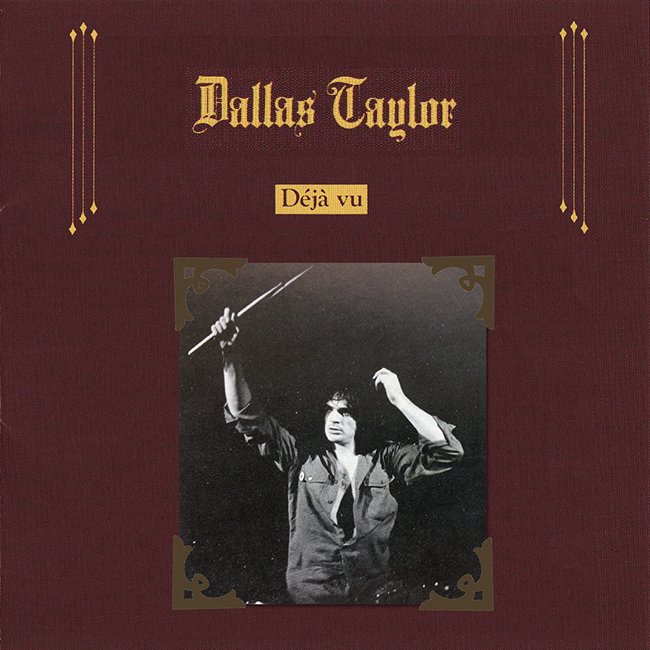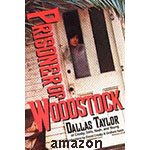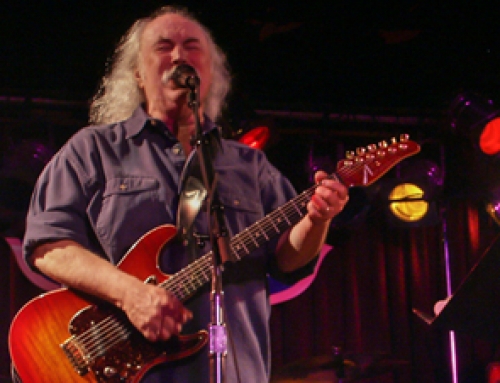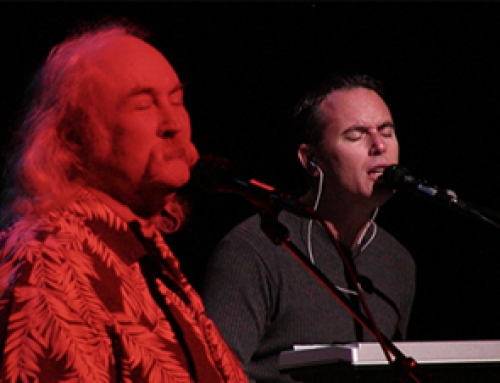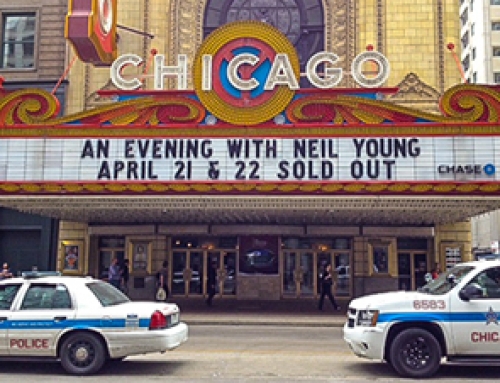4waysite.com
Date: 19 August, 2007
Photos: Henry Diltz, Tom Gundelfinger, Neal Preston as well as some others
Dallas Taylor was born in Denver Colorado in 1948 and grew up in San Antonio, Texas. At the age of ten Dallas’s mom took him to see the “Gene Krupa Story”. Dallas knew then that he wanted to be a drummer.
Best known as the drummer on Crosby, Stills and Nash’s debut album of 1969, he also appeared on Déjà Vu, their follow-up with Neil Young. After more albums, Dallas and Stills conceptualized a big band sound and thus was born Manassas. After many gold records and many tours, Dallas and Stills went their separate ways. There were many years of pain and struggle ahead, as well as more than a few life and death moments. Somehow, through it at all, Dallas and his music survived.
The former “Prisoner of Woodstock” has now begun a new life and another journey. After overcoming his own addictions, Dallas Taylor now works as a substance abuse interventionist with recovering drug addicts and families. He specializes in helping addicted musicians, addicted performers and entertainers with drug and alcoholism chemical dependencies.Dallas Taylor chronicled his life in the book “Prisoner Of Woodstock”, but for CSNY he is now a persona non grata and Tells me Y… In this exclusive interview he tells many wonderful tales from his time before his estrangement from the CSNY camp; stories that include many details that were previously unknown.
4WS: Dallas, before we talk about your life based around helping other addicts, I would like to go back to your musical roots: can you describe your drumming style?
DT: Dolf, I was influenced by Gene Krupa, a famous big band drummer in the 40s. He had a great subtle style that complimented the band.
4WS: In your book “Prisoner Of Woodstock” you state that it was your mother who arranged for you to take lessons with Mr. Hart. How long did you take lessons from him and did you take any more lessons after that?
DT: Mr. Hart was my only drum teacher. I took lessons from him for about a year. We didn’t have much money, and I know it was hard for my mom to pay for the lessons, but she was very supportive of my becoming a great drummer. I was on the road at 13. She used to travel with me because I was to young to get into clubs without her.
4WS: David Crosby didn’t like Jim Morrison. You and the Doors were in the same studio (Sunset Sound) with your psychedelic band Clear Light. I know I am not the first one to ask you this: what do you recall of him?
DT: I liked Jim. He was a big fan of my bands. Jim was a great singer and very visual. I heard the Doors live in a small club in LA and they where one of the tightest bands I’d ever heard.
4WS: You met Jimi Hendrix when you were with Clear Light and jammed with him. Since most of the time the tapes were rolling, I wonder if there are still tapes around.
DT: I don’t know, but I wouldn’t be surprised. Jimi and I were fighting over the same girl (Denise Betincourt) [perhaps Betancourt], so we didn’t talk much. He was a very quiet and shy person off stage.
4WS: So, before you joined CSN, you were with the band Clear Light. Are there recordings or CDs available?
DT: Yes, someone has created a Clear Light website and selling CD’s off it. I have a couple songs on my dallastaylorband.com website.

4WS: Clear Light consisted of – most unusually – two drummers. Are you still in touch with them and what is the other drummer, Michael Ney, doing now?
DT: I stay in touch with Doug Lubaun mostly. Bob Seal had a stroke a few years ago, but is recovering well. Doug just found Michael recently. I don’t know what he’s doing, but would like to see him.
4WS: John Sebastian introduced you to Stephen Stills. What do you remember about this first meeting and how did you become CSN’s drummer?
DT: Actually, I had heard that Stephen was looking for a drummer and don’t remember who gave me his phone number. We did a demo of “Suite: Judy Blue Eyes” with Doug Lubaun on bass. John and I were working on his album when I met Graham Nash. Stills, Nash and Crosby were singing some background for John. They went to London to rehearse their vocals for an upcoming “folk record” they where due to make for Atlantic, à la “Peter Paul and Mary”. We serendipitously met at Kennedy Airport. I arrived from LA. They arrived from London. We road the same limo out to John’s house were we where all going to stay. We jammed in John’s studio and that’s were they asked me to join. It went from folk to rock and roll with my joining the band.
4WS: What was the role of each member of Crosby, Stills and Nash in the beginning?
DT: Stills took on the role of “leader” . Crosby and Nash did pretty much what he wanted. Stephen was Ahmet Ertegun’s “fair haired boy” and Ahmet respected his decisions.
4WS: CSN’s first album “Crosby, Stills & Nash” (a.k.a. “the couch album”) was, for a big part, a Stills project, but you were involved in the mixing process also. What did Stephen and engineer Bill Halverson think about this?
DT: Stephen and I were responsible for all the rhythm tracks. We really played great together. It was nothing like anyone had ever seen before. Like “magic”. I remember I had to fight with them to get my drums up in the mix. They kept trying to bury them in the mix and push up the vocals. I lost the battle. The drums got buried.
4WS: The real connection was between Stephen Stills and you. Can you describe your relationship?
DT: I think I answered that in the previous question, but we became like brothers. We hung out together all the time. It was Stephen and I who flew back to New York and then England to try to find more players so we could play live.
4WS: Who did the conga sounding drums on “Suite: Judy Blue Eyes”, you or Stephen? You wrote in “Prisoner Of Woodstock” you overdubbed the drums on this song. The drums on the alternate mix of the CSN box set, sound more prominently than the final version from the album. Are they both yours and were you involved in that decision?
DT: Stephen played the back of his guitar for that “conga sound”. My drum parts were “buried” in the mix to favor the vocals. I fought to have them further up in the mix but was out numbered. Graham finally got it in the new mixes for the Box Set and brought my drums up in the mix. I wasn’t involved in the remix of the Box Set, but, yes, those were my drums.
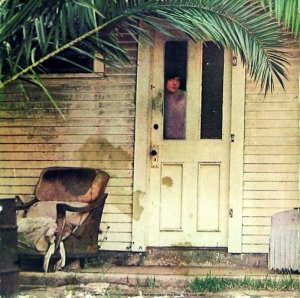
4WS: Almost the same question about “You Don’t Have to Cry”. On the final version, the drums seem to have disappeared, contrary to the unreleased studio version where you can clearly hear the drums. Again: Were you involved in that decision?
DT: No, at that time [1990] we weren’t speaking to each other. They tried to erase as much of me as they could get away with. Not very adult by the way. Graham hated my book and was pissed off at me.
4WS: I’ll get back to that later. Did Jim Gordon, who temporarily was CSN’s drummer because they could not wait until you could finish John Sebastian’s record, play drums on the final version of “Marrakesh Express”?
DT: Yes, and he did such a great job that we just left him in.
4WS: Your photo was pasted in on the cover of the “couch album” (but removed from the 2006 re-issue). This was Stephen’s idea, wasn’t it? What is the story of that and why was it done like that?
DT: Originally, on the ’69 album it was Stephen’s idea to put me on the back of the album. However, the building was torn down before we could go back to reshoot the photo, so, the photo was taken at David Crosby’s back door, and pasted into the doorway photo that already existed. Very clever work by Gary Burden the album designer and photographer [Henry Diltz]. We ended up in court over the Boxed Set and as I said, they have tried to erase me from history.
GOING BACK TO MAX YASGUR’S FARM
4WS: You seem to remember quite a lot about Woodstock. Stills was “scared shitless” and later explained it was mainly because of the fact his heroes (such as Jimi Hendrix) were back stage and watching him. Why were you scared? I understood it was because of the crowd.
DT: It was more about our peers watching us. They all gathered around behind us when we played.
4WS: Aren’t you afraid of crowds?
DT: No, I stopped doing drugs a long time ago. Cocaine makes you paranoid.
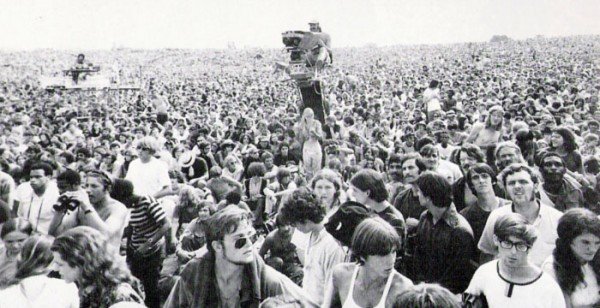
The Woodstock Festival, 1969. By courtesy of Dallas Taylor.
4WS: Is it true the helicopter had a rough landing for you at Woodstock? You wrote it was supposedly less than 25 feet off the ground when the tail rotor failed and it began to spin. The story goes the helicopter almost crashed and you and Graham Nash were almost killed.
DT: This is true. It was a very scary moment.
4WS: Stills landed before you, but where was Crosby?
DT: I’m not sure when David landed. It seems to me, that he rode with Stephen in a separate helicopter. Graham rode with me.
4WS: In your book you mention some names of unknown people who you ran into at Woodstock. After publishing your book in 1994, did anyone have a déjà vu and contact you? Guinnevere for example?
DT: Guinnevere is a fictitious name, and no, I have heard from no one at Woodstock.
TELL ME Y
4WS: Lets move to CSN and Y. Was it a given you would also become the drummer when Neil Young got involved and the Y was added to CSN?
DT: Yes, I was part of the decision to bring Neil into the band. I had a bad feeling because of his and Stephen’s fighting in Buffalo Springfield. I voted no.
4WS: So, Neil wasn’t your and Stephen’s first choice…
DT: No, we asked Phil Everly, George Harrison, Eric Clapton, and Steve Winwood, all of which turned us down. We asked Rick James to play bass but he said no.
4WS: The previous question suggests you were deeply involved in the CSNY project, but the name of the group was… Crosby, Stills, Nash & Young. Being the drummer, did you feel you were expendable and is this the naked truth about drummers?
DT: Absolutely! I saw the writing on the wall. Mostly because of David Geffen and Elliot Roberts.

4WS: Did you, back in the late 60’s and early 1970, already write songs and did you present them to CSNY like Greg Reeves unsuccessfully did?
DT: No I started writing with Stephen during Manassas
4WS: You were with CSNY almost from the inception. Was it Rick James who got Greg Reeves involved?
DT: Yes, he did bring us Greg Reeves, via Neil Young. We had asked Rick to play bass but he passed..
4WS: What ever happened to Greg Reeves BTW?
DT: He was very young and I think all the star stuff went to his head, plus way too much pot. Stephen couldn’t tolerate him, which was a mistake because Neil and Greg were very close. Rumor is Greg was only 15 and had a fake driver’s license that said he was 19. I have not heard from Greg since he was fired from the band. I heard rumors that he spent some time in jail for drugs, but, I can’t say for sure. I have no idea what he is doing now.
4WS: Do drummers and bass players have a special musical relationship?
DT: Yes, it is vital that we “click”.
4WS: CSNY said “You’ll be the mystery guy”, which you didn’t like that much. Why were you labeled like this?
DT: Mostly because all the artwork was in on the “couch album” prior to my joining the band, and the managers didn’t really want me in as a partner. The band, especially Stephen, had to fight for me to even get what I got.
Mostly it was Stephen who insisted I was to be an equal partner. Plus, we couldn’t come up with a name for the band, and Atlantic liked CROSBY, STILLS, and NASH as the name.
4WS: Déjà Vu was a completely different project. You said in an interview that it started to go badly when Neil came into the band. What happened?
DT: Ego!!!!!!!!!!!!! And Drugs!!!!!!! Fighting over who’s songs were going to make it on the album, and just petty bullshit stuff.
4WS: Most of the songs were individual efforts (except for “Woodstock”, “Almost Cut My Hair” and “Helpless” ). Is this correct?
DT: Mostly, it was Neil that would take his stuff home after we laid down the basic tracks. Then he brought them back for CSN vocals. Very weird and childish… Almost like “I’m taking my marbles and going home”.
4WS: First it was Stills who was sitting behind the soundboard, but later it was Bill Halverson who got involved. What was the reason?
DT: Bill was always involved. It was his genius that knew when to push the record button when we were playing. A lot of the time, we didn’t even know he had recorded something. Also he was a genius at editing. Perfect cuts every time. Some of those songs are combinations of several different takes. You could never tell.
4WS: Was it mainly a Stills, Halverson & Taylor effort indeed as one can read in the book “Crosby, Stills, Nash and sometimes Young”?
DT: It was Stephen myself and Bill that spent most of the time in the studio together. Sometimes Stephen would get me up at #am and we’d go into the studio to record an idea.
4WS: You once said that Déjà Vu would not have been the same without you on it. As you now of course expect me to ask, what was your (creative) contribution?
DT: The “feel”, the drum parts, the incredible groove that Stephen and I had together. Listen to the drums, and you tell me…..
4WS: I will surely tell you later on, but first another Stephen. Stephen Barncard (CSN’s engineer) was not credited on the cover of Déjà Vu. What was his role?
DT: Bill Halverson was the engineer at the Record Plant sessions. Bill Halverson was a brilliant engineer. He made the acoustic guitar sound right in your face, and my drums sounded live. But it was his editing ability that really set him apart. He could take clips from three or four different takes and make it sound like one take. Everything was starting to fall apart during Déjà Vu and it was Bill Halverson that got us through the record. I don’t know who Stephen Barncard was, unless he engineered Neil’s stuff out side the main sessions. That’s some new information to me.
4WS: Speaking of the cover: on Déjà Vu you were not pasted in, but (next to CSNY and Greg Reeves) photographed by Tom Gundelfinger (now called Tom O’Neal). The atmosphere represented the Civil War era and Gundelfinger took the pictures with an antique camera from the 19th century. What do you remember of that session?
DT: The cover was Stephen’s idea. He was a big Civil War buff. The camera belonged to Graham Nash. He collected antique cameras. The photo was taken at David Crosby’s house north of Sausalito California. The dog wandered into the picture accidentally and we kept the shot. We still don’t know where the dog came from, or who he or she belonged to. Stephen called it “Fred”.
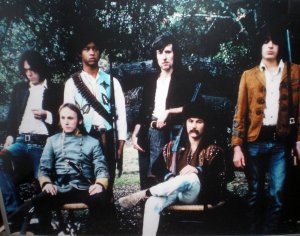
Photo by Tom Gundelfinger (now called Tom O’Neal)
4WS: “Carry On” has an interesting groove and rhythm. It starts after almost a minute with the hi-hat, then some percussion (that persists throughout the song). Did you (as the artwork tells us) or Stills do the percussion and what about the arrangements in general?
DT: The song was decidedly pieced together from two different songs. Stephen played the congas over the recorded track. I remember recording the second half of the song. My brand new Porsche had been stolen from San Francisco Airport and I was really pissed. I think it shows in the track.
4WS: A question about the beat: what kind of time signature is it?
DT: It’s all in 4/4 time. The first part is a shuffle, and the second part is straight ahead rock and roll 4/4.
4WS: Bill Halverson (engineer) seemed to have an alcohol problem. According to Stephen Barncard, his wife unexpectedly stormed into the studio and made some noise when she came to pick him up (source: the book “Crosby, Stills, Nash and sometimes Young”). Did you guys have a negative drug influence on each other?
DT: The cocaine and alcohol was flowing freely. We were all acting crazy from the stuff. It was the beginning of the end of the band. At least that first era of the band that included me and Greg. If Stephen Barncard was part time engineer, that shows you how fucked up I was. Bill Halverson would have had a piece of the action, so if this Barncard guy came in, he would have been paid session rate.
4WS: There was, following a gig in Denver, on 12 May 1970, an explosion of sensitive egos. According to Dave Zimmer’s excellent book “Crosby, Stills & Nash: The Biography”, Young was in a bitter conflict with you over your playing and said “Either he goes, or I go” and you dramatically described in your book “Prisoner Of Woodstock” what happened. What was the musical conflict about, or wasn’t it a musical matter at all..?
DT: First of all, it was Stephen that Neil wanted fired. Neil threw his guitar down in the middle of a song and walked off the stage. After that Neil met with myself, Graham and David and wanted to continue the tour with out Stephen. I said “no fucking way”, and flew back to LA with Stephen. It was the first time I had ever seen Stephen cry.
When we got back to LA , Ahmed Ertegun had called and threatened to have everyone’s legs broken if the tour wasn’t completed as CROSBY STILLS NASH AND YOUNG. It was then than Neil said” If I have to work with Stephen, then Dallas has to go”. I was a staunch ally of Stephen’s. I’ll never forget that day. I was out, and no one defended me. Not even Stills.
It was my closeness with Stephen that got me fired. Neil couldn’t stand Stephen, and resented it when Greg was fired. I was “payback.” At least that’s how it seemed to me.
4WS: How did you feel when the only CSNY live performances officially released featured Johny Barbata and not you?
DT: How do you think I felt? It was the worst time of my life. My drug use escalated to a suicidal point. I was out at the peak of our success. They had the balls to ask me to show Barbata my drum parts, and like an asshole…I did.
4WS: From CSNY to S: one of my favorite Stills songs is “Go Back Home” that appeared on his first solo album with Eric Clapton on 2nd lead guitar, you on drums and… Johny Barbata on drums as well…! Two drummers – how come?
DT: No, there was only my drums on that track. In Fact it was “take 1” Johny Barbata, but he did not play on any of the later records. There are not two drummers on “Go Back Home”.
4WS: “Go Back Home” originally was a song of 14 minutes, but according to Bill Halverson he made a mistake and the drummer(s?) had to do a great deal of work to fix it. What do you recall?
DT: Did you listen to “Go Back Home”? It was done in one take with just one drummer…me. It is magic; the magic only one take could have been.
4WS: You were there when the “giraffe photo” was shot for the cover of Stills’ first album. Was is the story behind the red giraffe?
DT: I wasn’t really around during that photo, but think a girlfriend had given him the giraffe. Maybe Véronique Sanson [It could have been for Rita Coolidge; Stephen Stills had not yet met Veronique].
4WS: You also played on Stills’ second and third solo album – any special memories?
DT: “Fishes and Scorpions”, “Change Partners”, all my best work.
4WS: Interesting maybe for CSNY fans and I have to admit I just noticed it the other day: CSNY’s photographer Henry Diltz got credited on the vocals on Stills’ 2nd album. Have you heard him sing?
DT: Henry Diltz [is a] great photographer, not a great singer. He must have sang on a drunken group session.
4WS: In the early 70’s you were working with Stills on Stolen Stills – an album that is to day still shelved. According to an article from Rolling Stone in 1973 (see Articles section of 4waysite.com) you played a prominent role and you hoped to make an album of your own. Which songs did this unreleased album contain, what was your contribution and why did your album never see the light of day?
DT: These must have been the infamous drunken Record Plant sessions. I was too drunk to finish my record.
4WS: In the biography “The Operator”, music manager David Geffen (who is legendary for being outspoken about several issues) describes Crosby as the “least talented” of CSNY. Do you agree?
DT: David had an ego to fill Dodger Stadium, but was a talented song writer. David Geffen wouldn’t know a great song if it slapped him in the face.
4WS: Needless to say CSNY is a politically involved band. Did (or do) you agree with their political views?
DT: Any halfwit can see out government is fucked up. Of course we agree politically.
4WS: Lets talk about some drum colleagues of yours and first I quote Johny Barbata from his book (“The Legendary Live of a Rock Star Drummer”, page 53): “I had met Dallas Taylor through Paul Rothschild and we were good friends. Dallas was a very good drummer.” What do you think of him and are you still in touch?
DT: I think Johny is a nice guy and good drummer as well, but not as good as I was.
4WS: Another quote that comes from Johny Barbata (“The Legendary Live of a Rock Star Drummer”, page 81): “I didn’t have a lot of respect for Russ Kunkel, because he was hanging around the CSN&Y gigs and trying to get in with them. Sure he was a good studio drummer and kissed everybody’s ass, but he was not a drummers drummer, like Jim Keltner, my friend was”. What do you think of Jim Keltner and… Russ Kunkel?
DT: I think they are some of the greatest drummers around.
4WS: There are more drummers who played during different periods with CSN/Y. Do you personally know them? Joe Vitale for example?
DT: Although I do know Joe Vitale, they went through drummers like Spinal Tap. I didn’t much follow what was going on.
4WS: Can you describe the (musical) differences between them and you?
DT: We each had our own style. You can hear the difference on the first CSN and Déjà Vu records compared to the other stuff.
4WS: When there was some tension between CSNY in the past, did you ever feel like acting as a go between when tension arose?
DT: I was the voice of reason for awhile, but so was everyone else. Most of the time I would just stand there in horror watching my dream crumble.
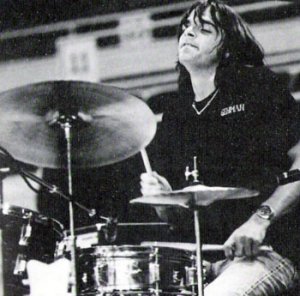
4WS: When did you first realize that Manassas was becoming a real band?
DT: It was in the studio in Florida Criteria with Ron and Howard Albert. We all enjoyed each others company, and we were having fun. The songs just kept flowing. Bill Wyman was in town and played on one or two songs, Love Gangster, I believe, was one of them. He loved the band. and want to join the band right there on the spot. It felt like a band we recorded most of the songs live. I was a very bright moment in our lives till I caught Stills flying to New York to take out a huge advance which meant he didn’t have to pay up. I said I would quit if he didn’t guarantee my money in writing. He paid up a part of the money and we continued to have great fun in the studio. We discussed going to England to rehearse for a world tour.
4WS: Is it true that Bill Wyman wanted to join Manassas?
DT: Yes that is true. He told me this at his home in the south of France. He said “My feelings were hurt that you guys didn’t ask me to join. I would have quit the Stones to play music with you”. That is why Bill asked me to join him in the South of France to play on his solo records.
4WS: What were some of those early marathon sessions like?
DT: I loved being in the studio for days. There were no clocks, so you couldn’t tell night from day, time was suspended. We would stay awake for days playing music.
4WS: What was it like living in England with Stephen at his house in Surrey?
DT: Stephen wrote a song called “Johnny’s Garden”, which was for the gardener named Johnny. The house previously belonged to Peter Sellers and then Ringo during the Beatle’s heyday. There was a small lake on the property with swan and ducks. There were horses and a riding ring. Also, a separate movie theater with projection. That is where we rehearsed Manassas. We where based out of the house while we toured Europe. There were some great memories. None of us wanted to leave there.
4WS: And when did you stay with Stephen at his house in Gold Hill Colorado?
DT: I stayed with Stephen in the Nederland house while we planned our next move for a third solo album. That house was where we put together what was to become Manassas.
4WS: How would you describe him as a friend?
DT: Stephen could be a great friend. He had called me after Four Way Street tour and asked me to join him for his solo efforts. It wasn’t till the cocaine use got really bad that things started going down hill.
4WS: What is the reason Manassas unfortunately never really broke through?
DT: That’s a good question. I wish I knew the answer. To this day Manassas is one of the most underrated bands in history. Manassas was the best band I ever played in. Full of talent.
4WS: Were you able to flex your muscles as a drummer more with Manassas than with CSN/Y?
DT: Yes, Stephen and I were always more “rock and roll” than the others. I think the first Manassas album was our best work together. I got producing and song writing credit on the record along with Chris Hillman. We were the driving force of the band.
4WS: Chris Hillman says Ahmet Ertegun [Atlantic Records chairman who died last year] personally wanted more Stills songs on the 2nd album “Down The Road” and – for example – a song called “Mama Told Me So” that you co-wrote, had to be deleted. Is this correct?
DT: Yes Ahmet hated the second album. I told him he was “full of shit”. Not a great career move on my part. The album tanked as a result. Also, looking back on it Ahmet was right. The songs weren’t that great. Again, the drugs and alcohol got the best of us.
4WS: Do you have any contact with Chris Hillman today?
DT: No, we’ve all gone our separate ways. The last time I saw Chris was when he played with his band Desert Rose at my benefit in 1990 at the Santa Monica Civic along with Don Henley and a then rare appearance by CSN&Y.
4WS: Later in 1974, Stills went on tour with CSNY. Was this the nail in the coffin of Manassas?
DT: No, the band had already “self destructed”.
4WS: What are your favorite Manassas memories – live and in the studio?
DT: Recording at Criteria Studios with Ron and Howie Albert. Also our live show at Madison Square Garden. The crowd went crazy. It was the best show I had ever done.
4WS: I recently read a story about “Lost tapes”, that supposedly appear on eBay, containing interviews with you that were conducted from December 1986, to February of 1987. The “Lost tapes” were never used. Do these tapes exist?
DT: I wouldn’t be surprised if they did. All kinds of old stuff is appearing on You Tube and such.
4WS: On 31 March 1990 Neil Young rejoined CSN for a concert in Santa Monica, CA to benefit you when you were in need of a liver transplant. Why was the Awareness Benefit concert never released as a live album?
DT: It was meant to be a personal thing. Absolutely no cameras or recording equipment was allowed.
4WS: Can you please – and I know I am not the first one to ask – explain the title of your book “Prisoner Of Woodstock” that you published in 1994?
DT: The title and book was about my decline from the positive feeling that was at Woodstock festival to the darkness of my addiction. Woodstock and the sixties represented the drug culture in a positive light, but that’s not how it all ended for me.
4WS: As I mentioned before, the real connection was between you and Stephen Stills. Why didn’t he write the foreword?
DT: You would have to ask Stephen that one.
4WS: It is my understanding you are for CSNY still a persona non grata, but I would like to hear your side of the story. Nash and Crosby wrote a foreword in “Prisoner Of Woodstock”, but weren’t they aware of what you wrote (about them) when they wrote the foreword?
DT: They were fully aware of what I wrote. You’d have to ask Graham and David that. Graham had talked to me about putting together the Boxed Set and we had gone through some pictures of me one night during Christmas at his house that were to go into the Boxed Set. I had shown David a draft of the book.
4WS: Do you know what exactly upset them and do you understand that?
DT: I still don’t know what upset them. I was 10 times worse on myself as [I was] on them. The book was the truth as I saw it. Nothing more.
4WS: Why did you sue them and did you try and resolve the matter prior to suing them? If so, how did you try and resolve it amicably?
DT: It was Irving Azoff [former manager of the Eagles and record business mogul] that tried to negotiate a reasonable settlement. He’s the one that told me I was getting screwed on the Boxed Set and So Far. We where talking about millions of dollars that wasn’t going to my kids. As soon as the book came out, Graham pulled all my photos from the Boxed Set and refused to pay me for it. So, they left me no choice but to bring a lawyer. It was then that I found out how they really felt about me. They were not my friends.
4WS: Were you ever advised not to pursue your suit against CSNY?
DT: No, in fact people kept pushing me to sue. In hindsight, I see it was not worth the heartache.
4WS: You and Stephen Stills used to be rather close. Do you have any contact with him now?
DT: No in fact they seem to keep erasing me from t-shirts album covers, etc. They even tried to replace my drums but couldn’t.
NEW LIFE – DALLAS TAYLOR 2.0
4WS: When I read your book “Prisoner Of Woodstock”, I noticed it is sometimes very detailed. Given the fact you used to be an addicted person, I think it is quite remarkable. Did you write a dairy?
DT: I sat with a friend of mine and went over thousands of pages of notes to put the book together. It was very cathartic.
4WS: You wrote “I’d made him [Stephen Stills] the cause of all my problems for at least a decade”. How do you view that situation now?
DT: I see that we made some of the greatest music ever made, and that is enough.
4WS: Where did drugs first enter the picture? Was there a particular reason or event and did people like Jim Morrison influence you, or was it a result of the fact you felt (as you describe in your book) hurt and insulted when the question of the band name came up?
DT: We were all doing drugs In fact I gave Jim Morrison his first bag of cocaine. I was that hurt by the name. I was more fearful of Neil coming into the band and fucking it up.
4WS: More important: how did you kick drugs?
DT: I stopped in 1984. I attempted suicide with the butcher knife because I couldn’t stop doing drugs.
4WS: Why do some people survive drugs (David Crosby, you and Keith Richards) and other people (Janis Joplin, Jimi Hendrix, etc.) pass away? Were you just lucky or did you all-in-all know where the limit was?
DT: None of us had any limits on anything especially drugs. I can’t answer why I didn’t die and they did. Just dumb luck…I guess.

4WS: Your life is based around helping other addicts. What do you do exactly and do you only work with celebrity clientele?
DT: I work with anyone who needs it. I find that helping others helps me. I work with families or bands who have a person in trouble, and get them in treatment.
4WS: According to your News Release (“Dallas Taylor Plays His Heart Out” – 4 July 2007), your success rate is “impressive”. What is your success rate and how do you work?
DT: I think because of my musical background, I can get through to people better.
4WS: Did you have to go to school to become a Certified Addiction Specialist?
DT: I had to go through much training. I was trained by the best in the world. All pioneers of addiction science.
4WS: If so, what school did you attend and how long did you have to attend school and what are the requirements for becoming a Certified Addiction Specialist?
DT: 1,000 hours of supervised on the job teaching. 100 CEU’s [Continuing Education Units] yearly, and $10,000.000 worth of malpractice insurance.
4WS: Michael Finnigan’s wife Candy is also a drug counselor. Do you ever work with her?
DT: Yes on a couple occasions, but not very much.
4WS: Kurt Cobain checked himself in, but he just walked out. The rest is history… Wouldn’t it be better to keep people in the facility until they are ready to cope with the outside world again?
DT: In California it is against the law to hold an adult in a treatment center against their will.
EPILOGUE
4WS: Can you tell me about your other musical interests now: what other artist’s work interests you?
DT: I have retired from the music business for now. My wife and I listen to 40′s big band music.
4WS: Do you still play (and write?) music?
DT: Not lately.
4WS: Do you play other instruments and do you sing as well?
DT: Yes I have a song writing partner named David Neely. We have written and recorded 27 songs in my home studio. We are hanging on to them for now.
4WS: A standard-question of 4WaySite: what is in your CD-player now?
DT: My 27 songs that David and I have written.
4WS: In an interview you said “The (music) business is finally the snake that ate itself”, but can’t the internet generate new opportunities?
DT: Of course, and it has. In fact it is the new face of the dying business. Thank god.
4WS: The most important question perhaps: how is your health now? Have you already had the kidney transplant?
DT: My wife gave me a kidney six months ago, so now I have a kidney and a liver. I am truly blessed.
4WS: Looking back at your life, what would you have done differently in retrospect?
DT: Stay away from the drugs and alcohol. It took everything from a lot of us.
4WS: Is there a funny Dallas Taylor-CSN/Y story that comes to mind?
DT: I think the helicopter ride to Woodstock and the look on our faces when it dropped was priceless.
4WS: The final question is: what’s your current motivation – your next goal?
DT: Considering all I been through. I intend to take life one day at a time and enjoy each day as if it were my last…..because it could just be.
4WS: Dallas, thanks for being so open and responsive and I would like to say enjoy each day.
